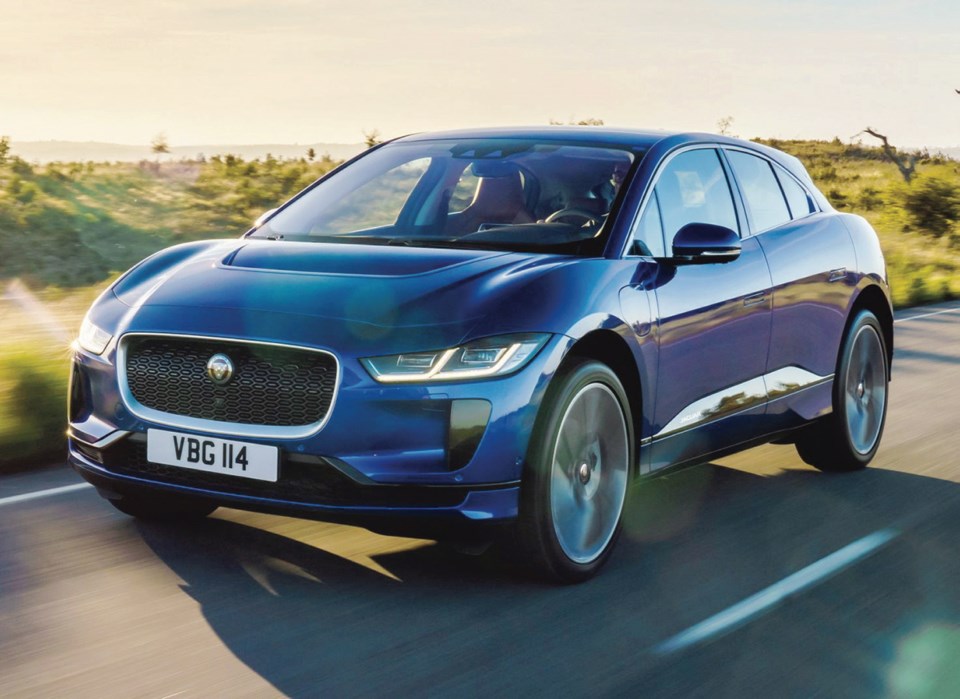The battery-powered I-Pace hatchback breaks new ground for Jaguar. Aside from Tesla, Jaguar is one of the first premium automakers to take a complete pass on fuel pumps. Others are heading our way, and soon.
It seems that Jaguar’s philosophy is that if you’re installing an electric powertrain, you shouldn’t get too weird when it comes to design. Instead of sporting a blunt Tesla-like nose, the I-Pace actually looks like a Jaguar. It’s not just for show, as it directs airflow to cool the batteries.
A narrow channel just above the grille directs incoming air through the hood vent, then over the roof and down between the hatchback’s window and roof spoiler. Jaguar says the air stream eliminates the need for a rear wiper, but obviously not when the car is stationary.
The rest of the I-Pace is sleek and aerodynamic; however, it lacks the cargo space of Jaguar’s F-Pace utility wagon, even with an added stowage bin under the relatively stubby hood. The F-Pace is similar in length to the I-Pace, but has double the cargo volume.
The interior and dashboard are unique to the I-Pace and appear more luxurious, certainly compared with the closest (in price) Tesla Model S with its touchscreen-dominated cockpit. The gauges and controls are certainly high-tech-looking, but they still would look right at home in any fossil-fuel-powered luxury vehicle. The 25-centimetre touchscreen displays driving range, battery life and braking-regeneration status, as well as the infotainment choices and navigation mapping. Traditional ventilation-system dials are located on the floor console, directly above the forward, reverse and park switches (replacing a conventional shifter).
Pushing the start button brings to life the I-Pace’s twin electric motors, one at each end of the vehicle. Combined, they produce 394 horsepower and 512 pound-feet of torque the very moment your right foot presses the accelerator. At speeds below 50 km/h, only the rear motor is functioning, which makes the battery charge last longer.
Jaguar’s stopwatch confirms a zero-to-100 km/h time of 4.5 seconds, which is quite quick considering the I-Pace weighs a hefty 2,180 kilograms. Much of that bulk belongs to the 432 battery cells located in the floor.
As with Tesla’s models, the I-Pace’s battery location lowers the centre of gravity to help keep the electric Jag flat and stable while driving.
At full charge, I-Pace range is estimated at 377 kilometres (about the same as a base Tesla Model S), but that number will decrease in cold-winter conditions and with aggressive accelerator-pedal inputs.
The charging time — an electric vehicle’s Achilles heel — is about 13 hours (from zero to 100 per cent) with a Level 2 240-volt charger. A 50-killowatt direct-current commercial fast-charger can cut that time to about 85 minutes for an 80 per cent top-up.
Once under way, you can choose to run silently or with artificially enhanced whirring motor sounds piped through the audio system.
The base I-Pace starts at $89,400 in Canada, including destination charges. It has dual-zone climate control, navigation, panoramic sunroof and a number of crash-avoiding dynamic-safety technologies, such as emergency braking.
The I-Pace is also equipped with active air suspension that slightly lowers the car above 105 km/h, which improves aerodynamics. The ground clearance can also be increased by the driver when tackling rough roads.
Eventually, better-equipped SE and HSE models will join the lineup, but at introduction the fully loaded $106,200 First Edition comes with unique paint, 20-inch wheels, 18-way heated and cooled sport seats, quad-zone climate control and pothole-absorbing adaptive suspension.
The I-Pace is obviously for buyers seeking luxury appointments and rapid movement without the need to gas up. Less obvious is the statement Jaguar is making about its technical expertise and the where the brand is headed in the future.
Jaguar’s future? You’re looking at it.
The spec sheet
Type: Four-door, all-wheel-drive hatchback
Engine (h.p.): Twin electric motors (394, combined)
Transmission: Single-speed direct-drive
Market position: Starting in the 2019 model year, Jaguar and a number of premium all-electric vehicles from established automakers are poised to challenge upstart Tesla, which has had the category to itself since the 2013 model year.
Points: Tidy design will very likely persuade buyers to at least check it out. • Attractive interior has a premium look that matches the exterior. • A quick car, as you might expect. • Charging times must be shortened before electric vehicles become truly viable. • Competitively priced, but emerging new arrivals could give Jaguar a run for its money.
Active safety: Blind-spot warning with cross-traffic backup alert (std.); active cruise control (std.); emergency braking (std.); lane-departure warning (std.)
Fuel economy, L/100 km(e) (city/hwy): n.a.
Base price (incl. destination): $89,4000



